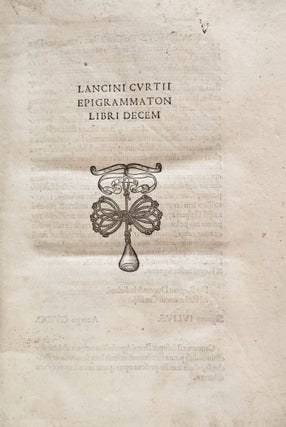Epigrammaton libri decem e Epigrammaton libri decem decados secundae.
Milano: Philippe Foyot per Rocco & Ambrosio da Valle, 1521. Item #974 First edition of this important book of epigrams and love poetry by Lancino Curti, published posthumously by his nephew Gaspare della Chiesa. Curti’s work constitutes one of the most important sources of the cultural life of Milan from the end of the 15th and the first decade of the 16th century. In particular it documents the court of Lodovico il Moro, the French occupation of Milan in 1499, the exile of Lodovico, expulsion of the French by the Swiss and the instillation of Ludovico’s son Massimiliano to the throne, and his removal in 1512 when the French reasserted their control of the city. Curti’s poetry is a mirror to his times and contains important historical information on the events taking place in Milan during this chaotic period in its history. In his poems Curti describes the art, music and literature that flourished and mentions the names of those who contributed to the cultural life of the City including Leonardo, Franchino Gaffurio, Antonio Fregoso, and he chronicled the activities of Il Moro, his marriage to Beatrice d’Este, and the French invasion. His love poetry is also important for its form, as he experimented with its meter and rhyme and creates a number of acrostic and palindrome poems new to the genre. He is remembered for combining the romantic with the heroic and documenting his age in a manner both original and useful to later day scholars. Curti’s Epigrammaton is also remembered for some of its verse on Sodom and the licentious language he used to describe “un plaisir très ordinaire.” The large woodcut on the title-page of part two represents ‘Fame’ in the form of a winged woman, with the body covered with eyes, ears and tongues, holding a torch in one hand and a whip in the other. Rare in American libraries; OCLC cites copies at Harvard, UCLA, and Newberry Library, and NUC adds U. Michigan. Brunet, Manual des Libraire, II p. 453. Sander, Le Livre á figures italien, I, p. 399.
Two parts on one volume. Large 8vo. 280 x 190 mm., [11 x 7 ¼ inches]. [18] including a blank leaf, 161, [1] ff.; [16], 146 ff. Large woodcut frontispiece introducing the second part of an image representing and a printer’s device which appears three times. Bound in contemporary vellum; spine stained brown, probably by the original glue and some spotting to the boards.
Price: $11,000.00




